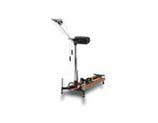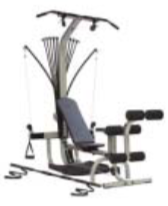Keeping fit
Keeping fit is important for a number of reasons, including the fact that you feel better, you function better, and you are less prone to injury. As an example of the reduction of injury, it turns out that older people fall largely because they lose their balance, grab onto something for support, don’t have enough hand- and arm-strength to support themselves, and fall.
The sad part is that keeping in adequate physical condition is, for most of us, a matter of choice, with the tradeoff being fitness for time. The object, therefore, is to maximize the fitness (strength, aerobic capacity, and flexibility) while minimizing the time. For those of us entering our declining golden years – that is to say those of us over 50 – current research indicates that the shift needs to be from aerobic to strength training. Flexibility is always a given. Obviously, before you launch into any exercise program, you should have a quick chat with your physician to make sure there are no problems that would preclude this.
Flexibility
In terms of time, flexibility is the easiest to deal with. We have found the SynerStretch program from Health for Life (http://www.healthforlife.com/) to be excellent, and doing the stretching exercises takes under ten minutes a session.
With flexibility training, as with all exercise, keep in mind that you took a long time to lose flexibility, and that you should plan on doing your flexibility exercise for some time before you get flexible again. If you try to rush the process you are likely to injure yourself, not become flexible faster.
Aerobic Conditioning
Aerobics are the next easiest, as there are any number of possible ways to get aerobic training. If you do an hour and a half of aerobic training a week (three half-hour sessions, or six quarter-hour sessions) you should be fine. Note that we are talking about aerobic training, which means that you must monitor your heart rate to keep your pulse in an appropriate training range. This means you must have a heart-rate monitor. There are many such monitors around. We use monitors from Polar (http://www.polarusa.com/).
As you would expect, there are various approaches to figuring out the training range. The American Heart Association recommends calculating a maximum heart rate by subtracting your age from 220, or 220-age. Thus, if you were 63 years old, your maximum heart rate would be 157.
They then suggest that the range to build endurance would be 50% to 75% of the maximum, or, for our 63 year old, a low range of .5 x 157 = 78.5, and .75 x 157 = 117.7. In practical terms this means you want to spend a half hour with your heart rate between 80 and 120. It will probably take five minutes to reach that heart rate, and you need to follow it with a five minute cool-down period, as you let the rate drift down toward normal.
An alternative approach makes the formula for maximum heart rate 21- minus half your age, from which you then subtract ten percent of your bodyweight, or (210 – .5 x age) – (.1 x bodyweight). Thus, if you were 63 years old, your maximum heart rate would be 163.
They then suggest that the range to build endurance would be 70% to 80% of the maximum, or, for our 63 year old, a low range of .7 x 157 = 114.31, and .8 x 157 = 130.64. In practical terms this means you want to spend a half hour with your heart rate between 115 and 130. (If you are losing weight, this formula suggests the fat burning rate to be 60% to 70%, or, in this case 95 to 115.) It will probably take five minutes to reach that heart rate, and you need to follow it with a five minute cool-down period, as you let the rate drift down toward normal.
Keep in mind that the cool down period is critical. If you get your heart really pumping and then suddenly stop exercising, you face the possibility of fainting or, worst case, dying, as your blood pressure plummets.
you face the possibility of fainting or, worst case, dying, as your blood pressure plummets.
Getting quickly to the target heart rate range, maintaining the heart rate in this range for the specified time, and then tapering safely off to a normal heart rate all require some thought. There are a lot of options, starting with running and ending with various machines. Our personal favorite is the Nordic Track, largely because it puts so little stress on our knees.
Strength Training
Strength training can be the most difficult area to address, both in terms of the rich set of choices, and in terms of the fact that it is increasingly difficult to stay in top shape as one grows older. However, increasingly difficult does not mean overly difficult. In fact, even if one has allowed oneself to get out of shape, getting back in shape is more difficult than when one is 20, but, even so, not all that difficult.
We believe that the most effective way for to retain or regain your physical strength involves use of machines. One approach is to join a gym, which, of course, has a lot of virtues. The problem with a gym is that it can be overly time-intensive for the busy person. An alternative would be the home gym.
We opted for the home gym. We did this because, even though there is a gym two blocks from our office, we realized that by the time we strolled over to the gym, got dressed, and hit the machines we would already be finished exercising at the office. On the other hand, we know people who don’t have the discipline to exercise without the social pressure of a gym, and, preferably, a personal trainer.
 There are a lot of choices for home gyms. After a good deal of investigation we opted for the BowFlex, in our case the BowFlex Ultimate XTLU. As is normal in the world of technology, this was the top of the line unit when we bought it, but there is now an Ultimate II, which is somewhat different. This doesn’t bother us in the least, as most of the exercises are the same, and we expect to be long dead before we exhaust the utility of the device.
There are a lot of choices for home gyms. After a good deal of investigation we opted for the BowFlex, in our case the BowFlex Ultimate XTLU. As is normal in the world of technology, this was the top of the line unit when we bought it, but there is now an Ultimate II, which is somewhat different. This doesn’t bother us in the least, as most of the exercises are the same, and we expect to be long dead before we exhaust the utility of the device.
The BowFlex is an extremely effective and versatile piece of exercise equipment. This is important, because you need to change your exercise routine regularly. This means that you should do one routine for a month, then change to another for a month, then change to yet another.
One of the dangers with any piece of exercise equipment is over-enthusiasm. In this case, the risk is that you will use too much resistance. We ourselves fell prey to this, and for a short period of time, went through more discomfort that was reasonable. We learned our lesson from this, and, based on our experience, we STRONGLY urge you to keep the resistance to the point where you can do the appropriate number of repetitions cleanly, and without strain. This will allow you to gain strength without a needless amount of muscle and tendon pain.
Keep in mind that you are not in a race, and will be exercising for the rest of your life. There is no great benefit to causing yourself needless discomfort. If it took you ten or twenty or thirty years to get out of shape, there is no reason to think you should be able to undo this in two months…
The combination of aerobic exercise, flexibility exercise, and strength exercise can add decades of functionality to your life. This is worth the time and effort it will require.

